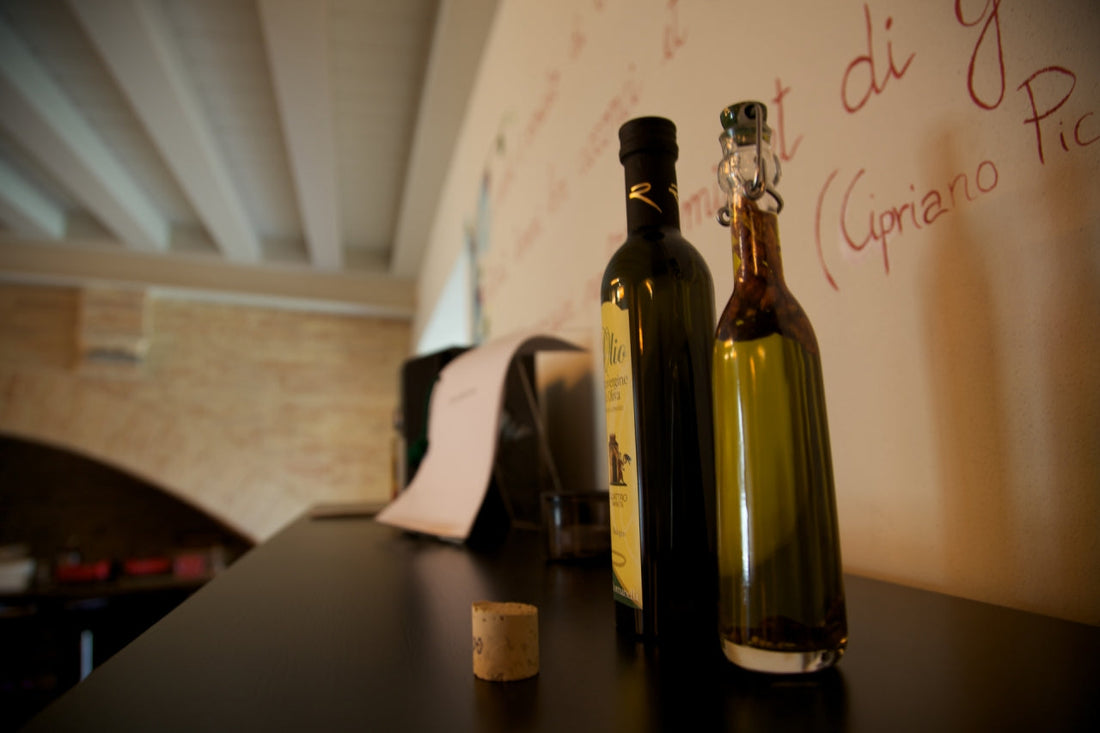
Discovering Umbrian Olive Oil: A Hidden Gem of Italy
Share
When most people think of Italian olive oil, their minds jump to Sicily or maybe Puglia. But there’s a quieter, greener region producing some of the finest extra virgin olive oil in the country, renowned in the world: Umbria.
Tucked in the center of Italy, Umbria is often called "The Green Heart of Italy," and for good reason. Rolling hills, medieval villages, and olive groves as far as the eye can see make this region a true olive oil paradise. If you're a curious traveler or a lover of good food, discovering Umbrian olive oil will feel like finding liquid gold.
When speaking about Umbrian olive oil, the region is often divided into 3 “macro-areas” of production, each one with its unique taste. However, among the many towns that produce excellent olive oil, Trevi is often considered the olive oil capital of Umbria, as its oil is usually praised for the exceptional quality, rich flavor, and perfect balance of bitterness and spice.

What Makes Umbrian Olive Oil Special?
Umbrian olive oil stands out for its balance, intensity, and freshness. The region's altitude, soil, and climate contribute to olives that are rich in polyphenols (those good-for-you antioxidants) and strong in character. The oil tends to be bold, slightly spicy, and pleasantly bitter—a sign of its freshness and quality. In fact, Umbrian olive oil is usually stronger than the olive oil from southern Italy or the Greek olive oil.
Unlike mass-market oils, Umbrian extra virgin olive oil is often made in small batches by family-run farms. Each bottle tells a story of place, harvest, and tradition, that contributes to increasing the quality and authenticity of the product.
Umbrian olive oil is not all the same. Different subregions bring out different flavor profiles, thanks to varying altitudes, soil types, olive varieties and time of harvesting.
Colli Assisi-Spoleto
This is probably the most well-known DOP (Protected Designation of Origin) area in Umbria, where also the aforementioned town of Trevi is included. The oil from this zone is often medium to robust in flavor, with a slightly grassy aroma and a peppery finish. It's typically made from varieties like Moraiolo, Frantoio, and Leccino. Thanks to its boldness, is perfect paired with red meat and with pastas like Carbonara, Amatriciana or Strangozzi alla Spoletina.
Colli Martani
The Colli Martani zone is a bit more subtle in style. Olive oil from here tends to be softer and more delicate, with notes of almond, green apple, and fresh herbs. It’s perfect for drizzling over fish or soft cheeses, or ideal for hearty soups, roasted meats, and enjoying with fresh bread for a good bruschetta.
Lago Trasimeno Area
Near the border with Tuscany, the Trasimeno Lake area is known for a rare local cultivar: the Dolce Agogia olive. The oil here is fruitier and rounder, with less bitterness and spice. It’s approachable and elegant, great for newcomers to bold Italian oils. This type of olive oil is perfect for salads, thanks to its lighter taste, but also on bruschettas for those looking for less spiciness.
Olive Varieties and How They Shape Flavor
Umbria uses a mix of olive cultivars, and each brings something different to the final product:
-
Moraiolo: Spicy, herbaceous, and deeply green. Adds punch and depth.
-
Frantoio: Smooth and balanced with hints of artichoke and grass.
-
Leccino: Milder and fruitier, it rounds out stronger olives.
-
Dolce Agogia: Native to Lake Trasimeno. Light, sweet, and nutty.
The blend—or mono-varietal choice—in each bottle changes the character of the oil, which is why tasting different producers can feel like exploring wine. When looking for a good Umbrian olive oil, always check for the type of olives used, so you can have a better understanding of what you are buying, making sure to make the right choice.

How to Taste Olive Oil Like an Italian
If you’re traveling through Umbria or just ordering a bottle online, knowing how to taste olive oil can make a big difference:
-
Pour a small amount into a glass and warm it with your hands.
-
Smell it. You should notice fresh, green scents—like tomato leaf, artichoke, or herbs.
-
Take a small sip and let it coat your tongue. Real olive oil should taste alive. Slight bitterness and a peppery kick in the throat are good signs.
-
Pair it well. Use robust oils on grilled meats and hearty soups. Delicate oils are perfect on salads or vegetables.
And, of course, don’t forget to have it on a slice of toasted bread! In Umbria, we’d say that a slice of toasted bread with a generous drizzle of olive oil is “la morte sua” — meaning “it’s the perfect match,” the best possible way to enjoy it.
Why It Belongs in Your Kitchen
Umbrian olive oil isn’t just a condiment; it’s an experience. It connects you to centuries of craftsmanship, the rhythm of the harvest, and the soul of a region where food is still made with care, time, and passion.
Whether you're drizzling it over a bowl of lentils, preparing a salad or finishing a plate of pasta, maybe with a glass of wine in hand, a good bottle of Umbrian olive oil brings Italy to your table and to your dishes.
And once you taste it, you’ll understand why so many fall in love with this quiet little region and its bold, beautiful oil.
Curious to learn more about Umbria and its flavors? Follow us on Instagram or subscribe to our newsletter for more regional food stories, travel tips, and hidden gems from the heart of Italy.
